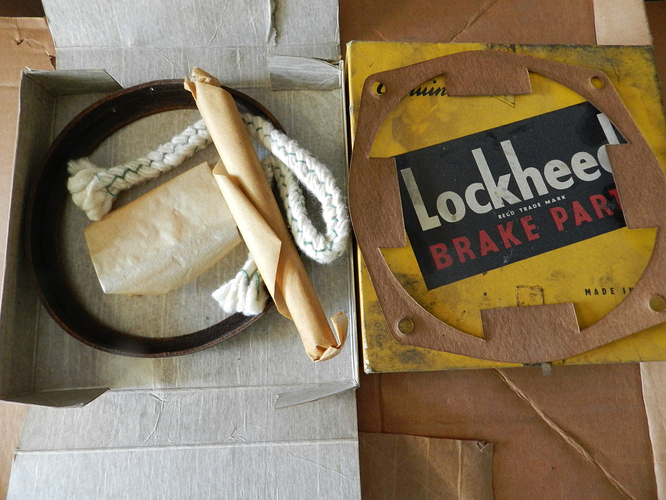Has anyone installed a vacuum booster to an XK140 with front disk brakes??
HI,
Don’t know whether originality is an issue for you, but the XK 140 had an optional Brake Servo which differs from the XK 150 version.
Service Bulletin No.235 of January 1958, introduces a modification kit to add a Vacuum Brake servo to XK140: “For XK.140 owners who would prefer less effort to operate the brake pedal a servo kit is now available from the Jaguar Spares Department under Part Number 7076”.
I have such a 5 1/2 " Lockheed brake servo, which is normally fitted in the LHS battery box near the master cylinder, but decided not to install the servo as I have absolutely no problems with the brake pedal and the car stops perfectly with the original drum brakes.
As you have already opted for disc brakes and originality is apparently no issue, I would recommend the later XK 150 servo (6 7/8 ") or even a modern after market version which is offered by many companies. Spare parts for the original Lockheed servos are becoming difficult to find.
Bob K.
bob I would love to see some pics of this booster I have been chasing one for years
I think the reason that they chose the smaller unit was so the boost was not that large?
Terry,
See photos attached. This is the original servo incl. aluminium tag with Lockheed number 89368, as used on early 2.4 and 3.4 litre saloons. The difference with the later 6 7/8 servo of the XK 150 is (apart from the diameter of course) the absence of an outside vacuum rubber tube to the piston drum.
I assume you have Jaguar SB 235 (and 230). Lockheed also provided a fitting instruction Form. No. 1117 with a complete description for the Coupé models, split in LHD and RHD. I can send you a copy if you want.
The reason I decided not to install this servo is (apart from the fact that the car stops well without effort, the hydraulic piston housing has some corrosion (not too bad) but the company I ask to overhaul this servo refused to give any guarantee. I also found a new and correct Lockheed kit for this servo.
Can send you more photos in detail. If you’re interested in the servo, contact me via PM as I have no intention to use it.
Bob
.
you state that your 140 stops fine with no booster. I just turned all drummers and fitted new shoes and my car stops but only with significant effort. any Ideas? The rear seems to be worse than the front.
b. davis
My 140 stopped very well without any servo or booster. Yes of course you have to push the pedal a bit harder compared to modern cars. I used a rebuild master cylinder and new wheel cylinders but the brake system was otherwise completely standard. I could even lock the front and rear wheels (if I wanted to).
The only problem I had was the varying point at which the left and right front started braking, even after many times carefully checking all components including the automatic adjuster system. After this short moment of “inconvenience” the braking was fine and efficient.
I guess this typical “half a second” drum brake phenomena is the only point where disc brakes would offer an advantage.
Bob K.
I acquired a period non-vacuum Lockheed brake booster KL.72542, but never fitted it as I’ve always considered the standard drum brakes to be superb on old stock asbestos linings.
Sold the booster to a Mini Cooper buff as they were apparently fitted by BMC to competition cars.
Chris T.
My car also pulls up without significant effort , and could lock them up if I wanted to . All completely standard. I don’t feel the need for “modern” brakes . Each to their own .
Sorry, I sold it a couple of years ago Terry. There was no interest on a well-known auction site at the time (£100, NOS) and I eventually accepted a modest offer off a local chap recreating a period competition Mini Cooper.
Chris T
thanks for update terry
I have the standard drum setup on my 140 but did change the brake shoe linings to “velvet touch” racing linings to eliminate brake fade. When heated they provide more grip. I am not sure that they are still available.
there is no way I can lock up wheels on my 140–front or back. still a mystery to me.
The Lockheed diagram suggests a transfer from the main master to a smaller master (with no vacuum assist). This is a wild guess but I suspect that the bore of the secondary master is significantly smaller than the 1inch bore of the primary master as in general the smaller the bore the more pressure per inch of travel of the brake pin. I set up a “NASCAR” set up on my xk150 with two master cylinders with a balance bar between them to adjust the front/rear bias. It works well with four wheel discs with no booster. I had to experiment with the size of the bore for the two masters but i adopted masters with smaller bores than the one inch standard master cylinder.
b.d.




